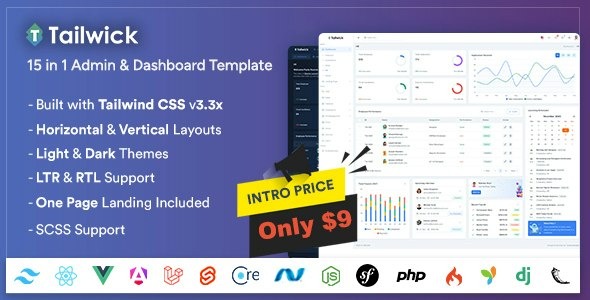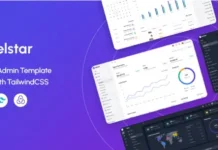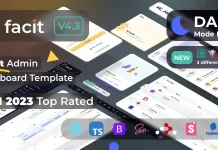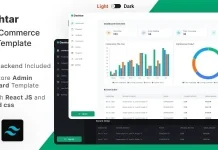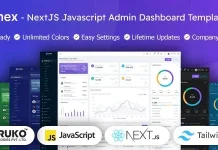Tailwick Tailwind CSS Admin & Dashboard Template Nulled is an innovative web development framework that combines the simplicity of Tailwind CSS with the robustness of popular JavaScript libraries. It aims to streamline the development process by providing a comprehensive toolkit for building responsive, user-friendly, and visually appealing websites. In this blog post, we will explore the various aspects of Tailwick, discuss who it is ideal for, weigh its pros and cons, and compare it with other popular alternatives.
In the fast-paced world of web development, having a framework that balances simplicity with powerful capabilities is essential. Tailwick is designed to meet this need by integrating the utility-first CSS framework, Tailwind CSS, with modern JavaScript libraries, offering developers a streamlined and efficient development experience. Whether you are building a simple blog or a complex web application, Tailwick Tailwind CSS Admin & Dashboard Template Free Download provides the tools you need to create high-quality, responsive websites with ease.
1. Features and Capabilities
a. Utility-First CSS: Tailwick leverages Tailwind CSS, a utility-first CSS framework, to provide developers with a wide range of utility classes. This approach allows for rapid prototyping and precise control over the design without writing custom CSS. Tailwind CSS’s modular nature makes it easy to create consistent and maintainable styles.
b. Seamless Integration with JavaScript Libraries: Tailwick is designed to work seamlessly with popular JavaScript libraries such as React, Vue.js, and Angular. This integration enables developers to build dynamic and interactive user interfaces with minimal effort. By combining the strengths of these libraries with Tailwind CSS, Tailwick offers a powerful toolkit for modern web development.
c. Responsive Design: Tailwick includes built-in responsive design utilities that make it easy to create websites that look great on any device. The framework provides a set of responsive utility classes that allow developers to adjust the layout and styling based on different screen sizes, ensuring a consistent user experience across all devices.
d. Customizable and Extensible: Tailwick is highly customizable, allowing developers to tailor the framework to meet their specific needs. With support for custom themes, plugins, and configuration options, Tailwick provides the flexibility to create unique designs and functionality. The framework’s extensibility ensures that it can adapt to a wide range of projects and requirements.
e. Comprehensive Documentation and Community Support: Tailwick comes with extensive documentation that covers all aspects of the framework, from installation to advanced usage. The active community support ensures that developers can find answers to their questions and share their experiences. This robust documentation and community involvement make it easy for developers of all skill levels to get started with Tailwick.
2. Who is Tailwick Ideal For?
a. Front-End Developers: Tailwick is ideal for front-end developers looking for a streamlined and efficient way to build responsive and visually appealing websites. The utility-first approach of Tailwind CSS, combined with the power of modern JavaScript libraries, allows developers to create high-quality user interfaces quickly.
b. Startups and Small Businesses: Startups and small businesses can benefit from Tailwick’s ability to accelerate the development process. The framework’s simplicity and flexibility enable small teams to build and deploy websites rapidly, helping them get to market faster and with a polished product.
c. Design-Driven Projects: Projects that prioritize design and user experience will find Tailwick particularly useful. The framework’s utility classes and responsive design features make it easy to implement intricate designs and ensure a consistent user experience across all devices.
d. Educational Institutions and Students: Educational institutions and students can use Tailwick to learn and teach modern web development practices. The comprehensive documentation and active community support make it an excellent resource for learning the fundamentals of web development and advanced techniques.
Pros and Cons of Tailwick
Pros:
- Utility-First Approach: Tailwind CSS provides a wide range of utility classes for rapid prototyping and precise control over design.
- Seamless Integration: Works well with popular JavaScript libraries like React, Vue.js, and Angular.
- Responsive Design: Built-in utilities for creating responsive layouts that look great on any device.
- Customizable: Highly customizable and extensible to meet specific project needs.
- Comprehensive Documentation: Extensive documentation and active community support for easy learning and troubleshooting.
Cons:
- Learning Curve: Developers new to the utility-first approach may need time to adjust and become proficient.
- Initial Setup: Initial configuration and setup can be complex, especially for beginners.
- Verbose HTML: Using utility classes can result in verbose HTML, which may be harder to read and maintain.
- Dependence on Tailwind CSS: Projects heavily reliant on Tailwind CSS may face challenges if the framework evolves or changes significantly.
Comparing Tailwick with Popular Alternatives
1. Bootstrap: Bootstrap is a widely-used CSS framework known for its comprehensive set of components and responsive design utilities. While Bootstrap provides a robust starting point for web development, it uses a component-based approach rather than the utility-first approach of Tailwick. Tailwick offers more granular control over styling and can be more flexible for custom designs.
2. Foundation: Foundation is another popular front-end framework that focuses on responsiveness and mobile-first design. Like Bootstrap, Foundation provides a set of pre-designed components. Tailwick, with its utility-first approach, allows for more customization and may be better suited for developers who prefer to build their styles from the ground up.
3. Bulma: Bulma is a modern CSS framework based on Flexbox. It offers a clean and straightforward way to create responsive designs. While Bulma is similar to Tailwick in its use of utility classes, Tailwick’s seamless integration with JavaScript libraries and extensive customization options provide additional advantages for complex projects.
4. Materialize: Materialize is a front-end framework based on Material Design principles. It offers a range of components and styles inspired by Google’s Material Design guidelines. Tailwick, by contrast, is more flexible and not tied to a specific design language, making it a better choice for projects that require unique or varied design aesthetics.
Tailwick Free Download is a powerful and versatile framework that combines the utility-first approach of Tailwind CSS with the robustness of modern JavaScript libraries. Ideal for front-end developers, startups, design-driven projects, and educational institutions, Tailwick offers a comprehensive set of tools for building responsive, user-friendly, and visually appealing websites.
Tailwick Free Download with other popular alternatives like Bootstrap, Foundation, Bulma, and Materialize, it is clear that Tailwick stands out for its flexibility, customization options, and seamless integration with JavaScript libraries. Whether you are looking to accelerate your development process, create intricate designs, or learn modern web development practices, Tailwick provides the capabilities and support needed to achieve your goals.

